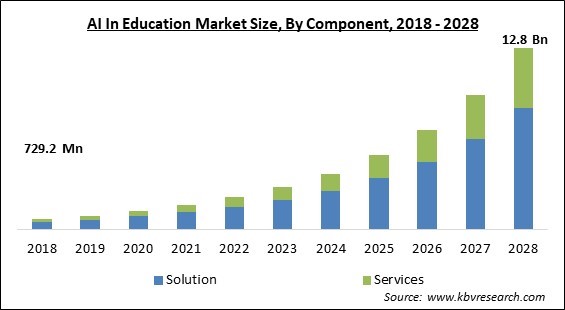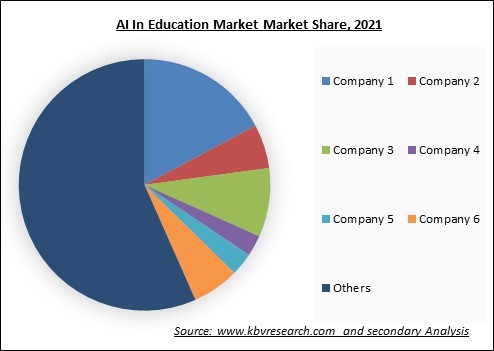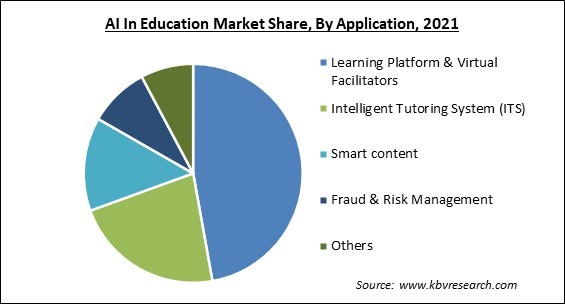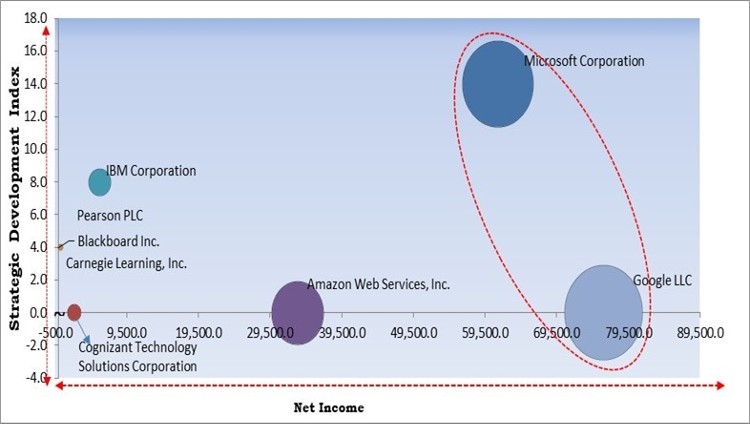The Global AI In Education Market size is expected to reach $12.8 billion by 2028, rising at a market growth of 33.5% CAGR during the forecast period.
Giving teachers, students, and educators a better experience is part of the application of AI in education. Numerous service providers are developing unique AI education solutions or services that connect to numerous education platforms. The demand for AI in education is also rising as online learning is becoming a more popular choice for skill development. As there is a growth in AI-backed business applications, tech corporations cooperated with colleges to introduce new training formats for AI talent in order to better fit with the development trends and latest industry developments.

Giving teachers, students, and educators a better experience is part of the application of AI in education. Numerous service providers are developing unique AI education solutions or services that connect to numerous education platforms. The demand for AI in education is also rising as online learning is becoming a more popular choice for skill development. As there is a growth in AI-backed business applications, tech corporations cooperated with colleges to introduce new training formats for AI talent in order to better fit with the development trends and latest industry developments.
Artificial intelligence has the ability to address some of the most significant issues facing education nowadays, such as innovative teaching and learning methods, and eventually quicken the realization of SDG 4. However, these quick technological advancements necessarily carry with them a number of risks and difficulties that have thus far surpassed regulatory structures and policy discussions. Enhanced education experience can be achieved with the help of AI technologies, and UNESCO is committed to assisting Member States in doing so while ensuring that the use of AI in educational settings is governed by the fundamental values of equity and inclusion.
The COVID-19 pandemic delivered a significant impact on the worldwide economy. Various businesses all over the world were majorly affected due to the pandemic. In addition, the advent of the pandemic also significantly disrupted the education infrastructure all over the world. Various industries were severely affected by the COVID-19 outbreak. The COVID-19 pandemic had a detrimental effect on the education sector. Schools colleges and other educational institutes all over the world were shut down, due to which, there was a drop in the demand for AI learning in in-person education.

The leading players in the market are competing with diverse innovative offerings to remain competitive in the market. The below illustration shows the percentage of revenue shared by some of the leading companies in the market. The leading players of the market are adopting various strategies in order to cater demand coming from the different industries. The key developmental strategies in the market are Acquisitions, and Partnerships & Collaborations.
One of the key factors that are driving the growth of the AI in education market is the fact that it significantly improves the learning and teaching experience. Vendors of AI technology are creating electronic gadgets with AI capabilities by creating sophisticated learning systems that enhance learning procedures. For educational institutions to survive in a world with cutthroat competition, they must provide the finest learning environment. For instance, Century Intelligent Learning created a classroom employing AI technology that allows teachers to create academic curricula online, allowing students to access their curricula whenever they choose.
The administrative team works continuously for hours, whether it be filing paperwork, sending texts and emails, getting in touch with students or their parents, or producing periodic reports. In a similar manner, professors and teachers must grade papers for tests and homework, plan lesson plans, prepare for upcoming classes, etc. It consumes a significant amount of time for these educators. The remaining time is set aside for marking test papers, creating lesson plans for future classes, and finishing up administrative tasks. The artificial intelligence expert can assist teachers in developing an AI system that would increase staff and student productivity.
The diffusion of digitalization in LMIC, or low- and middle-income countries, is very slow. This is attributed to the prevalence of the digital divide all over the world. The digital divide can be defined as the reduced digital growth of developing and underdeveloped countries in contrast to developed countries due to the lower penetration of technologies. There is a significant number of LMICs that are struggling to bring technological advancements. AI-enabled deployments are completely reliant on accessible data, IT infrastructures, and Internet of Things devices for gathering instances to produce correct results due to the absence of funding for the fundamental requirements of IT infrastructures within poor nations.

Based on component, the AI in education market is classified into solutions and services. In 2021, the services segment registered a significant revenue share of the AI in the education market. The growth of the segment is increasing due to the rise in online education brought on by the pandemic. Additionally, the market is being driven by rising government and private sector investments in AI education for the improvement of the educational system. Venture capitalists (VCs) invested significant amounts in AI businesses in 2020.
On the basis of deployment, the AI in education market is bifurcated into Cloud and On-premises. In 2021, the cloud segment procured the highest revenue share of the AI in the education market. Reduced ownership costs along with a growing demand for educational data sharing among international campuses are two reasons that have contributed to the expansion of the cloud segment. Additionally, it enables academic institutions to integrate cutting-edge AI technology into their current operating model without having to increase their capital expenditures.
By technology, the AI in education market is segmented into Natural Language Processing (NLP) and Machine Learning. In 2021, the natural language processing segment registered a significant revenue share of the AI in the education market. The bolstering growth of the segment is owing to an increase in the demand for virtual learning among colleges and universities. Investments from educational facilities are increasing in technological advancements in order to offer the best-in-class learning experience to their students. In addition, it would also streamline several teaching processes for teachers.
Based on application, the AI in education market is fragmented into Learning Platform & Virtual Facilitators, Intelligent Tutoring System (ITS), Smart content, Fraud and Risk Management and Others. In 2021, the learning platform and virtual facilitators segment acquired the biggest revenue share of the Ai in the education market. The growth of this segment is owing to the expansion of digital education learning technology. Additionally, employing a variety of abilities and advice relevant to social growth, virtual facilitators assist students in resolving challenging real-time social issues.
On the basis of end-use, the AI in education market is categorized into K-12 Education, Higher Education and Corporate Training & Learning. In 2021, the Corporate Training & Learning segment held a significant revenue share of the AI in the education market. Some of the major factors driving businesses to make the most of their resources are the rapidly shifting market conditions and growing market competition. Therefore, in order to stay up with the constantly shifting market expectations, firms must promptly train their staff members and keep them informed of the latest developments.
| Report Attribute | Details |
|---|---|
| Market size value in 2021 | USD 1.7 Billion |
| Market size forecast in 2028 | USD 12.8 Billion |
| Base Year | 2021 |
| Historical Period | 2018 to 2020 |
| Forecast Period | 2022 to 2028 |
| Revenue Growth Rate | CAGR of 33.5% from 2022 to 2028 |
| Number of Pages | 295 |
| Number of Tables | 522 |
| Report coverage | Market Trends, Revenue Estimation and Forecast, Market Share Analysis, Segmentation Analysis, Regional and Country Breakdown, Competitive Landscape, Companies Strategic Developments, Company Profiling |
| Segments covered | Component, Application, Deployment Mode, Technology, End-use, Region |
| Country scope | US, Canada, Mexico, Germany, UK, France, Russia, Spain, Italy, China, Japan, India, South Korea, Singapore, Malaysia, Brazil, Argentina, UAE, Saudi Arabia, South Africa, Nigeria |
| Growth Drivers |
|
| Restraints |
|
Region-wise, the AI in education market is analyzed across North America, Europe, Asia Pacific and LAMEA. In 2021, North America procured the maximum revenue share of the AI in the education market. The market in the region is being driven by elements including the presence of top organizations that create technology infrastructure facilities, solutions, and services, and the massive number of end-users utilizing educational gadgets for AI in education. For instance, the IBM corporation announced that it would train people in new skills through partnerships with business and academia.
Free Valuable Insights: Global AI In Education Market size to reach USD 12.8 Billion by 2028

The major strategies followed by the market participants are Partnerships. Based on the Analysis presented in the Cardinal matrix; Microsoft Corporation and Google LLC are the forerunners in the AI In Education Market. Companies such as Amazon Web Services, Inc., IBM Corporation and Pearson PLC are some of the key innovators in AI In Education Market.
The market research report covers the analysis of key stake holders of the market. Key companies profiled in the report include IBM Corporation, Microsoft Corporation, Google LLC, Cognizant Technology Solutions Corporation, Pearson PLC, Amazon Web Services, Inc., Carnegie Learning, Inc., Blackboard, Inc., BridgeU Limited, and DreamBox Learning, Inc.
By Component
By Application
By End Use
By Deployment Mode
By Technology
By Geography
The global AI In Education Market size is expected to reach $12.8 billion by 2028.
Enhanced Student and Teacher Experience are driving the market in coming years, however, Slow Digitalization Due to the Digital Divide restraints the growth of the market.
IBM Corporation, Microsoft Corporation, Google LLC, Cognizant Technology Solutions Corporation, Pearson PLC, Amazon Web Services, Inc., Carnegie Learning, Inc., Blackboard, Inc., BridgeU Limited, and DreamBox Learning, Inc.
The Solution segment acquired maximum revenue share in the Global AI In Education Market by Component in 2021 thereby, achieving a market value of $8.6 billion by 2028.
The Higher Education segment is leading the Global AI In Education Market by End-use in 2021 thereby, achieving a market value of $7.4 billion by 2028.
The North America market dominated the Global AI In Education Market by Region in 2021, and would continue to be a dominant market till 2028; thereby, achieving a market value of $4.3 billion by 2028.
Our team of dedicated experts can provide you with attractive expansion opportunities for your business.

